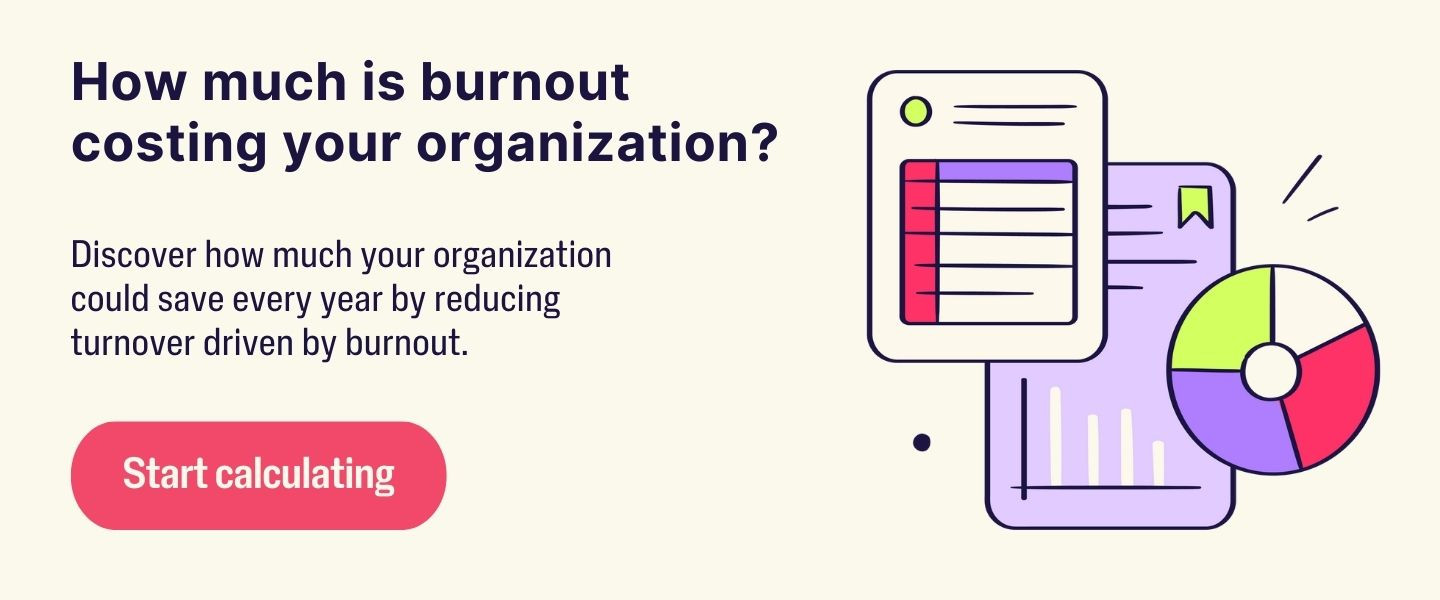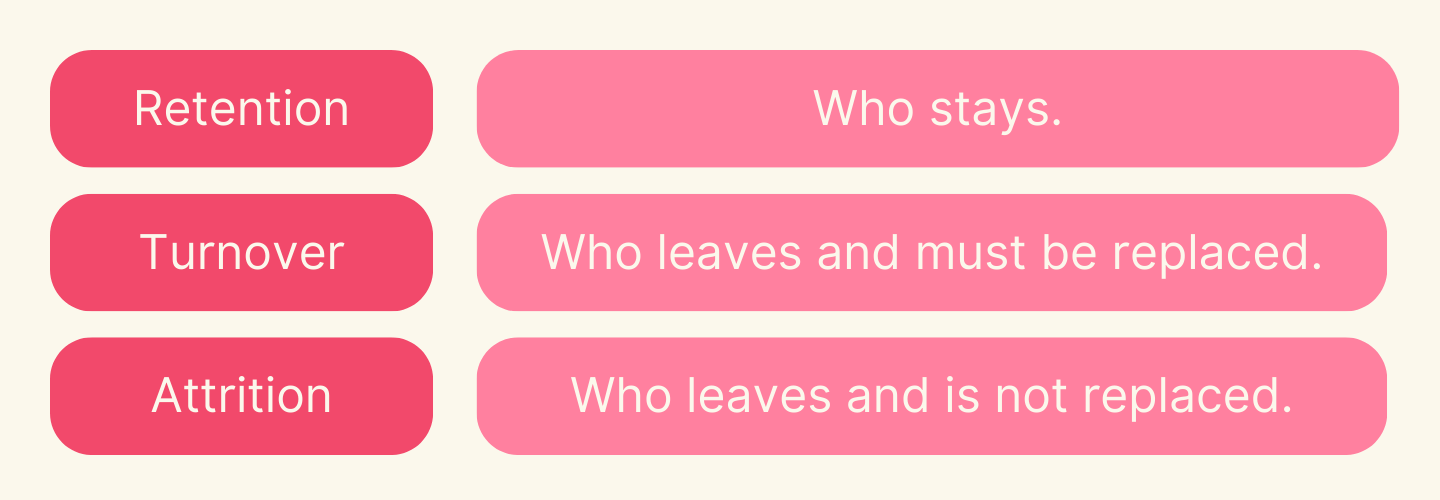Attrition vs Turnover vs Retention: Key Differences HR Must Know
Last Updated Nov 25, 2025

Key Takeaways
- Retention, turnover, and attrition measure different types of workforce movement, and mixing them up leads to bad reporting and even worse decisions. Clear definitions help HR leaders diagnose cultural strengths, spot risks, and plan ahead with accuracy. When your terminology is aligned, your people metrics stop conflicting and start informing your strategy.
- Retention is the clearest indicator of workplace stability and cultural health. High retention shows that employees feel supported, engaged, and willing to stay for the long term. When retention varies across teams, it signals where to focus improvements in leadership, workload, or career development.
- Turnover highlights disruption and cost, especially when valuable talent leaves voluntarily. Regrettable turnover exposes deeper problems in management, compensation, or culture that require swift action. Tracking who leaves—and why—helps you identify patterns early and intervene before more top performers walk out the door.
- Attrition reveals when the workforce is shrinking, either by design or by accident. Planned attrition supports restructuring or cost-saving goals, while unplanned attrition exposes gaps in succession planning or engagement. Understanding this nuance helps leaders avoid misinterpreting natural reductions as performance issues.
- Advanced people analytics turn these metrics from static numbers into predictive insights that power proactive talent strategy. Segmenting turnover and retention by tenure, role, or department uncovers hidden issues, while predictive models help forecast stay risk. When wellbeing data is included, HR leaders can act early to prevent burnout and protect top talent.
Turnover. Retention. Attrition. HR leaders hear these terms daily—but using them interchangeably can tank your strategy.
Each one tells a different story about your workforce. And if you're blurring the lines between them, you're missing the chance to diagnose deeper issues, highlight what’s working, and make smarter decisions about your people.
Retention shows who’s staying and signals cultural strength. Turnover flags disruption and triggers replacement costs. Attrition tells you when headcount drops—sometimes by design. Understanding the difference isn’t just smart. It’s essential.
Get clear on the language that drives your workforce decisions. Unlock the insights that help you move from reactive reporting to proactive planning. Ready to reframe how you look at people metrics?
Start here—and turn data into direction.

What Retention, Turnover, and Attrition Each Mean
If you want to lead workforce strategy with clarity, you need to speak the language precisely. These definitions aren’t just semantics—they’re your map to measuring what’s working, diagnosing what’s not, and planning what’s next. Let's break them down.

Employee Retention: The Metric of Stability
Retention is your North Star when it comes to measuring workplace satisfaction and cultural strength. It tells you how well your organization keeps the people it worked hard to recruit.
Definition: Employee retention is the percentage of employees who stay at your company over a specific time period. It reflects both employee loyalty and organizational health.
Focus: Who stays.
Why It Matters: High retention rates (typically 85% or higher) signal that your organization is supporting its people, engaging them meaningfully, and delivering on its employee value proposition. It’s not just about keeping people—it’s about keeping the right people for the long haul.
Employee Turnover: The Focus on Replacement
Turnover gets the most attention—and for good reason. It’s costly, both financially and operationally. But the key distinction here? Turnover includes only those roles you have to replace.
Definition: Employee turnover is the rate at which employees leave your organization and are replaced.
Focus: Who leaves and must be replaced.
Why It Matters: Whether turnover is voluntary or involuntary, it creates disruption. You're dealing with recruitment costs, lost productivity, training, and sometimes even drops in morale. Measuring turnover helps you spot trouble before it becomes a trend.
Employee Attrition: The Focus on Workforce Reduction
Attrition is often misunderstood—but here’s the critical difference: attrition isn’t always a problem. In fact, when managed strategically, it can be a quiet way to reshape your workforce without layoffs.
Definition: Employee attrition is the reduction in workforce that happens when people leave and their roles are not replaced.
Focus: Who leaves and is not replaced.
Why It Matters: Attrition can be planned (like retirements) or unplanned (unexpected resignations). When intentional, it can support cost-saving or restructuring strategies. When unintentional, it may point to missed opportunities in succession planning or cultural alignment.
Each of these terms offers a different lens on workforce health. Used correctly, they transform from buzzwords into business intelligence.
Up next: we’ll compare these side by side so you can see how they really stack up.
Retention vs. Attrition vs. Turnover: What’s the Difference?
Let’s line these three metrics up side by side—because the differences may be subtle, but the implications are huge. This table gives you a quick-glance way to align your terminology, reporting, and strategy.
Factor | Retention | Turnover | Attrition |
| Primary Focus | Employees who stay | Employees who leave and are replaced | Employees who leave and are not replaced |
| Impact on Headcount | Measures stability | Headcount remains relatively stable | Headcount is permanently reduced |
| Typical Measurement | Annually or bi-annually | Monthly, quarterly, or annually | Quarterly or annually (often for strategic review) |
| Voluntary vs. Involuntary | Focuses on voluntary stayers | Includes both voluntary resignations and involuntary terminations | Usually dominated by retirements or role eliminations |
Why this matters:
Confusing attrition with turnover can lead to poor budget planning. Mistaking low retention for high turnover might cause you to miss systemic culture issues. When you get these definitions aligned, you unlock cleaner reporting, better benchmarking, and smarter forecasting.
By clearly distinguishing these metrics in your reports and dashboards, you’re not just tracking change—you’re telling the story of your workforce. And that story should inform your strategy.
How Turnover, Retention, and Attrition Shape Your Talent Strategy
Let’s turn insight into action. Each of these metrics tells you something different about your workforce—and how you should respond.
This section breaks down what each metric reveals, what it means for your organization, and what to do next.
The Dangers of Regrettable Turnover
What It Tells You: High voluntary turnover in critical roles is a warning sign. These are the exits that hurt most—top performers leaving on their own terms.
What It Means: You may be facing issues with management quality, employee engagement, compensation competitiveness, or cultural misalignment.
What To Do Next:
- Use exit interviews and engagement surveys to spot recurring themes.
- Prioritize manager training where poor leadership is cited.
- Benchmark pay and benefits against industry standards.
- Look at tenure data to see if turnover is spiking early—your onboarding may need a refresh.
When Attrition Is a Strategic Opportunity
What It Tells You: Not all departures are losses. Attrition that doesn’t result in a backfill—like a retirement or a phased-out role—can be a strategic decision.
What It Means: Planned attrition supports workforce efficiency. But unplanned attrition, especially in roles that shouldn’t be left vacant, may indicate gaps in succession planning or workforce engagement.
What To Do Next:
- Incorporate retirement timelines into workforce plans.
- Document institutional knowledge with mentorships or training resources.
- Revisit your succession plans annually to ensure leadership continuity.
- Use exit interviews to distinguish between planned and unplanned attrition drivers.
The Retention Imperative: Investing in Staying Power
What It Tells You: Your ability to retain employees reflects the overall strength of your employee experience and company culture.
What It Means: High retention often points to an engaged, supported workforce. But if retention is strong in some departments and weak in others, it’s time to zoom in.
What To Do Next:
- Build career development programs that map clear L&D paths.
- Launch a recognition strategy that’s frequent, personalized, and peer-inclusive.
- Address burnout early: 90% of employees experienced burnout symptoms in the past year, and 39% feel it weekly.
- Offer flexibility and wellbeing benefits to reduce stress and increase loyalty.

Diving Deeper into People Analytics
You’ve mastered the basics—now it’s time to move beyond topline metrics and into the insights that fuel strategic decisions. Today’s HR leaders are leveraging more nuanced, segmented, and predictive data to not only understand what’s happening in the workforce, but why it’s happening, and what’s likely to happen next.
Beyond the Basics: Segmented and Specialized Metrics
What It Tells You: Standard retention and turnover rates are helpful—but they can mask problems (or successes) hiding in specific segments of your workforce.
What It Means: More targeted metrics can highlight early warning signs and opportunities that broad reporting can miss.
What To Do Next:
- Track New Hire Turnover within the first 90 days, 6 months, and 12 months to evaluate onboarding effectiveness.
- Monitor Retention by Department or job family to uncover pockets of disengagement or leadership gaps.
- Add Tenure-Based Turnover to see when in the employee lifecycle people are leaving—and why.
Use these insights to customize interventions. If first-year turnover is high in sales but not in tech, you may need to redesign your onboarding strategy by role.
Predictive Analytics: Forecasting Workforce Movement
What It Tells You: Not all valuable insights live in your HRIS or ATS. Predictive analytics uses patterns in engagement data to help forecast who might leave next—and why.
What It Means: You can take action before talent walks out the door. By connecting sentiment data to turnover patterns, you shift from reactive to proactive strategy.
What To Do Next:
- Use engagement survey items like “I see myself working here in two years” to create stay-risk models.
- Cross-reference this data with attrition history and demographic segments.
- Develop predictive dashboards that flag high-risk groups based on shifts in sentiment, performance, or attendance.
Consider layering predictive data with your wellbeing metrics. According to Wellhub’s 2026 report, 85% of employees would consider leaving a company that doesn’t prioritize wellbeing. That kind of signal belongs in your forecasting model.
When you use people analytics to drill down and look ahead, your HR strategy becomes dynamic and adaptive. These insights empower you to protect your talent pipeline, improve workforce planning, and build a culture where people stay—not because they have to, but because they want to.
Attrition vs. Turnover vs. Retention: FAQs
Let’s clear up the most common questions HR leaders and business stakeholders ask. Bookmark this section to settle terminology debates once and for all.
Are attrition and turnover the same?
Not quite. While both refer to employees leaving the organization, the key difference is whether the role is refilled.
- Turnover happens when an employee leaves and their role is replaced.
- Attrition happens when an employee leaves and their role is not replaced.Content...
Is attrition another word for turnover?
No. They are often used interchangeably—but shouldn't be. Attrition results in a permanent reduction in headcount, while turnover does not. Using the right term ensures accurate reporting and better workforce planning.
Is turnover the same as retention?
They’re opposites.
- Turnover tracks who leaves.
- Retention tracks who stays.
They are closely related, but not interchangeable. You can have low turnover but also low retention if you're not keeping the right employees over time.
What does a 10% attrition rate mean?
A 10% attrition rate means that over a set period (usually a year), 10% of your workforce left and their roles were not replaced. This may reflect planned workforce reductions—like retirements or restructuring—or unplanned losses that impact productivity and capacity.
What is the difference between attrition and retention?
Attrition measures how many employees you lost and didn’t replace.
Retention measures how many employees you successfully kept.
Attrition reflects workforce reduction. Retention reflects workforce stability.
Are retention and turnover inverse?
Generally, yes—but with nuance.
A high retention rate often correlates with low turnover. But it’s possible to have low turnover and low retention if you’re replacing employees quickly (e.g., constant churn in entry-level roles). Tracking both gives you the full picture.
Better Retention Starts with a Wellbeing-First Culture
High turnover, low retention, and unmanaged attrition can point to deeper issues—like burnout, poor leadership, and lack of engagement. Without clear insight into why employees leave or stay, it's easy to miss patterns that impact workforce planning and culture.
A strong employee wellbeing program helps prevent regrettable turnover and strengthens retention by addressing stress, burnout, and disengagement. Wellhub data shows that 85% of employees would only consider working for companies that care about their wellbeing. That makes employee wellbeing more than a perk—it’s a retention strategy.
Speak with a Wellhub Wellbeing Specialist to protect top talent, reduce costly turnover, and build a workplace people don’t want to leave.

Company healthcare costs drop by up to 35% with Wellhub*
See how we can help you reduce your healthcare spending.
[*] Based on proprietary research comparing healthcare costs of active Wellhub users to non-users.
Category
Share

The Wellhub Editorial Team empowers HR leaders to support worker wellbeing. Our original research, trend analyses, and helpful how-tos provide the tools they need to improve workforce wellness in today's fast-shifting professional landscape.
Subscribe
Our weekly newsletter is your source of education and inspiration to help you create a corporate wellness program that actually matters.
Subscribe
Our weekly newsletter is your source of education and inspiration to help you create a corporate wellness program that actually matters.
You May Also Like

Termination Letter Template: 3-Step HR Risk Guide | Wellhub
Protect every separation with a termination letter template, plus a 3-step HR framework that reduces legal risk, supports dignity, and keeps teams stable.

10 Exit Interview Questions to Ask | Wellhub
Discover the top 10 exit interview questions to ask employees. Gain valuable feedback, identify areas for improvement, and enhance your workplace culture.

Employee Retention Guide | Wellhub
Discover effective strategies for employee retention.Improve engagement, boost morale, and create a positive work environment to retain top talent.